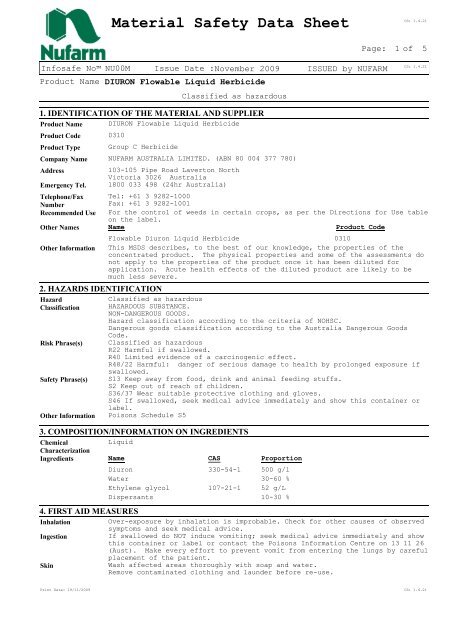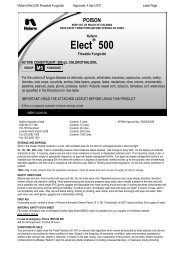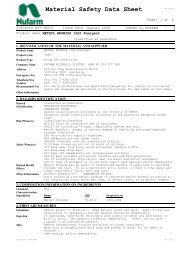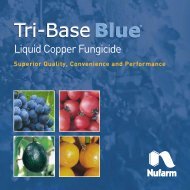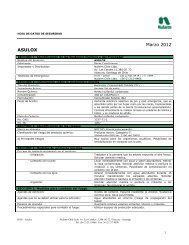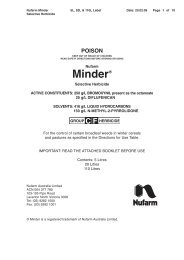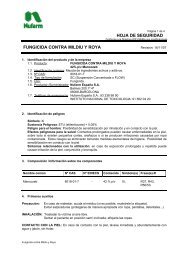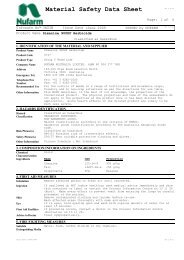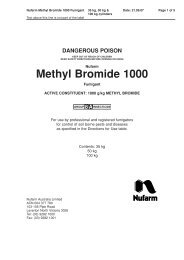MSDS - Nufarm
MSDS - Nufarm
MSDS - Nufarm
You also want an ePaper? Increase the reach of your titles
YUMPU automatically turns print PDFs into web optimized ePapers that Google loves.
Material Safety Data Sheet<br />
CS: 1.4.21<br />
Page: 1<br />
of<br />
5<br />
CS: 1.4.21<br />
Infosafe No NU00M Issue Date : November 2009 ISSUED by NUFARM<br />
Product Name DIURON Flowable Liquid Herbicide<br />
Classified as hazardous<br />
1. IDENTIFICATION OF THE MATERIAL AND SUPPLIER<br />
Product Name DIURON Flowable Liquid Herbicide<br />
Product Code 0310<br />
Product Type Group C Herbicide<br />
Company Name NUFARM AUSTRALIA LIMITED. (ABN 80 004 377 780)<br />
Address<br />
103-105 Pipe Road Laverton North<br />
Victoria 3026 Australia<br />
Emergency Tel. 1800 033 498 (24hr Australia)<br />
Telephone/Fax<br />
Number<br />
Tel: +61 3 9282-1000<br />
Fax: +61 3 9282-1001<br />
Recommended Use For the control of weeds in certain crops, as per the Directions for Use table<br />
Other Names<br />
on the label.<br />
Name<br />
Product Code<br />
Flowable Diuron Liquid Herbicide<br />
0310<br />
Other Information This <strong>MSDS</strong> describes, to the best of our knowledge, the properties of the<br />
concentrated product. The physical properties and some of the assessments do<br />
not apply to the properties of the product once it has been diluted for<br />
application. Acute health effects of the diluted product are likely to be<br />
much less severe.<br />
2. HAZARDS IDENTIFICATION<br />
Hazard<br />
Classified as hazardous<br />
Classification HAZARDOUS SUBSTANCE.<br />
NON-DANGEROUS GOODS.<br />
Hazard classification according to the criteria of NOHSC.<br />
Dangerous goods classification according to the Australia Dangerous Goods<br />
Code.<br />
Risk Phrase(s) Classified as hazardous<br />
R22 Harmful if swallowed.<br />
R40 Limited evidence of a carcinogenic effect.<br />
R48/22 Harmful: danger of serious damage to health by prolonged exposure if<br />
swallowed.<br />
Safety Phrase(s) S13 Keep away from food, drink and animal feeding stuffs.<br />
S2 Keep out of reach of children.<br />
S36/37 Wear suitable protective clothing and gloves.<br />
S46 If swallowed, seek medical advice immediately and show this container or<br />
label.<br />
Other Information Poisons Schedule S5<br />
3. COMPOSITION/INFORMATION ON INGREDIENTS<br />
Chemical<br />
Liquid<br />
Characterization<br />
Ingredients<br />
Name<br />
CAS<br />
Proportion<br />
Diuron<br />
330-54-1 500 g/l<br />
Water 30-60 %<br />
Ethylene glycol<br />
107-21-1 52 g/L<br />
Dispersants 10-30 %<br />
4. FIRST AID MEASURES<br />
Inhalation<br />
Over-exposure by inhalation is improbable. Check for other causes of observed<br />
symptoms and seek medical advice.<br />
Ingestion<br />
If swallowed do NOT induce vomiting; seek medical advice immediately and show<br />
this container or label or contact the Poisons Information Centre on 13 11 26<br />
(Aust). Make every effort to prevent vomit from entering the lungs by careful<br />
placement of the patient.<br />
Skin<br />
Wash affected areas thoroughly with soap and water.<br />
Remove contaminated clothing and launder before re-use.<br />
Print Date: 19/11/2009 CS: 1.4.21
Material Safety Data Sheet<br />
CS: 1.4.21<br />
Page: 2<br />
of<br />
5<br />
CS: 1.4.21<br />
Infosafe No NU00M Issue Date : November 2009 ISSUED by NUFARM<br />
Product Name DIURON Flowable Liquid Herbicide<br />
Eye<br />
Advice to Doctor<br />
Classified as hazardous<br />
If in eyes, hold eyelids open and wash with copious amounts of water for at<br />
least 15 minutes.<br />
Seek medical advice.<br />
Treat symptomatically.<br />
5. FIRE FIGHTING MEASURES<br />
Suitable<br />
If involved in a fire, the product will not burn. Choose extinguishing media<br />
Extinguishing Media to suit the burning material.<br />
Hazards from If involved in a fire, the dehydrated components may emit oxides of carbon and<br />
Combustion nitrogen, cyanides, phosgene and hydrogen chloride.<br />
Products<br />
Special Protective<br />
Equipment for fire<br />
fighters<br />
Specific Hazards<br />
Emergency Action in<br />
case of Fire<br />
Other Information<br />
Breathable air apparatus should be worn when fighting a fire in which diuron<br />
is involved.<br />
Considered low risk due to water content, however upon evaporation of water<br />
the product is combustible.<br />
If exposed to fire, keep container cool by spraying with water.<br />
STOP FIRE WATER FROM ENTERING DRAINS OR WATER BODIES.<br />
6. ACCIDENTAL RELEASE MEASURES<br />
Spills & Disposal Contain spill and absorb with clay, sand, soil or proprietary absorbent (such<br />
as vermiculite).<br />
Collect spilled material and waste in sealable open-top type containers for<br />
disposal.<br />
Personal Protection For appropriate personal protective equipment (PPE), refer Section 8.<br />
If product has dried out and the possibility of dust generation exists, wear a<br />
Clean-up Methods -<br />
Large Spillages<br />
7. HANDLING AND STORAGE<br />
Conditions for Safe<br />
Storage<br />
Other Information<br />
suitable respirator.<br />
If large liquid spills occur, attempt to recover as much spilt material from<br />
sumps and bunded areas before absorbing remaining material into vermiculite or<br />
other absorbent.<br />
Store in the closed, original container in a cool, well ventilated area.<br />
Do not store for prolonged periods in direct sunlight.<br />
Keep container tightly sealed and do not store with seed, fertilisers or<br />
foodstuffs.<br />
Always read the label and any attached leaflet before use.<br />
8. EXPOSURE CONTROLS/PERSONAL PROTECTION<br />
National Exposure<br />
Standards<br />
Name<br />
STEL<br />
TWA<br />
mg/m3 ppm mg/m3 ppm Footnote<br />
Diuron<br />
10<br />
Ethylene glycol<br />
120<br />
60<br />
Engineering Handle in well ventilated areas, generally natural ventilation is adequate.<br />
Controls<br />
Personal Protective<br />
Equipment<br />
Hygiene Measures<br />
When opening the container, preparing spray and using the prepared spray wear<br />
cotton overalls buttoned to the neck and wrist and a washable hat,<br />
elbow-length PVC gloves and goggles.<br />
After use and before eating, drinking or smoking, wash hands, arms and face<br />
thoroughly with soap and water.<br />
After each day's use, wash contaminated clothing and safety equipment.<br />
9. PHYSICAL AND CHEMICAL PROPERTIES<br />
Form<br />
Liquid<br />
Appearance Pale green liquid<br />
Boiling Point ~100°C (for water)<br />
Print Date: 19/11/2009 CS: 1.4.21
Material Safety Data Sheet<br />
CS: 1.4.21<br />
Page: 3<br />
of<br />
5<br />
CS: 1.4.21<br />
Infosafe No NU00M Issue Date : November 2009 ISSUED by NUFARM<br />
Product Name DIURON Flowable Liquid Herbicide<br />
Classified as hazardous<br />
Solubility in Water Disperses in water.<br />
Specific Gravity 1.160<br />
Vapour Pressure 1.1 x 10-3 mPa @ 25°C for diuron<br />
Volatile Component ~40% (water)<br />
Octanol/Water Kow Log P is 2.85 for diuron<br />
Partition Coefficient<br />
Flammability Non combustible material.<br />
Other Information<br />
10. STABILITY AND REACTIVITY<br />
Chemical Stability Stable under normal conditions.<br />
Hazardous Reactions Keep away from strong oxidising agents.<br />
Hazardous<br />
Hazardous polymerisation is not possible.<br />
Polymerization<br />
11. TOXICOLOGICAL INFORMATION<br />
Toxicology<br />
No harmful effects are expected if the precautions on the label and this <strong>MSDS</strong><br />
Information are followed.<br />
Inhalation<br />
May cause irritation to the respiratory tract.<br />
Ingestion<br />
Low toxicity.<br />
However, swallowing large amounts of concentrate may cause nausea and<br />
vomiting.<br />
Skin<br />
The concentrated product may cause slight irritation on contact.<br />
Eye<br />
May irritate the eyes.<br />
Chronic Effects Evidence from animal studies indicate that repeated or prolonged exposure to<br />
diuron can result in blood disorders.<br />
Reproductive No such effects have been observed in the absence of maternal toxicity.<br />
Toxicity<br />
Mutagenicity The weight of evidence indicates that diuron does not present a mutagenic<br />
risk.<br />
Carcinogenicity Diuron has been assessed in animals and some data exists that diuron is a<br />
substance which causes some concern for humans owing to possible carcinogenic<br />
effects from long term exposure, but in respect of which the available<br />
information is not adequate for making a satisfactory assessment.<br />
Acute Toxicity - Oral LD50 (rat) >3000 mg/kg for diuron<br />
Acute Toxicity - LD50 (rabbit) >2000 mg/kg for diuron<br />
Dermal<br />
Acute Toxicity - LC50 (rat) (4hr) >5 mg/l for diuron<br />
Inhalation<br />
Eye Irritation Mild eye irritant.<br />
Skin Irritation Mild skin irritant.<br />
Skin Sensitisation Product is not a skin sensitiser.<br />
Other Information The Australian Acceptable Daily Intake (ADI) for diuron for a human is 0.007<br />
mg/kg/day, set for the public for daily, lifetime exposure. This is based on<br />
the NOEL of 0.7 mg/kg/day, the level determined to show no effects during long<br />
term exposure for the most sensitive indicators and the most sensitive<br />
species. (Ref: Comm. Dept. of Health and Ageing Office of Chemical Safety,<br />
'ADI List', September 2007).<br />
12. ECOLOGICAL INFORMATION<br />
Persistence / Average field half life of diuron is 90 - 180 days.<br />
Degradability<br />
Print Date: 19/11/2009 CS: 1.4.21
Material Safety Data Sheet<br />
CS: 1.4.21<br />
Page: 4<br />
of<br />
5<br />
CS: 1.4.21<br />
Infosafe No NU00M Issue Date : November 2009 ISSUED by NUFARM<br />
Product Name DIURON Flowable Liquid Herbicide<br />
Known Harmful<br />
Effects on the<br />
Environment<br />
Environ. Protection<br />
Acute Toxicity - Fish<br />
Classified as hazardous<br />
The product is a marine pollutant for sea transport.<br />
Spray drift should be avoided, read the label for more information.<br />
Do NOT apply, drain or flush equipment on or near desirable trees or other<br />
plants, or on an area where their roots extend, or in locations where the<br />
chemical may be washed or moved into contact with their roots.<br />
The following is data for the active ingredient, diuron.<br />
LC50 (96hr) for rainbow trout is 5.6 mg/l.<br />
LC50 (96hr) for bluegill sunfish is 5.9 mg/l.<br />
LC50 (48hr) for daphnia is 12 mg/l for diuron.<br />
Acute Toxicity -<br />
Daphnia<br />
Acute Toxicity - EC50 (120hr) for Selanastrum capricornutum is 0.022 mg/l.<br />
Algae<br />
Acute Toxicity - Not toxic to bees.<br />
Other Organisms Not toxic to birds.<br />
13. DISPOSAL CONSIDERATIONS<br />
Product Disposal<br />
Container Disposal<br />
On site disposal of the concentrated product is not acceptable.<br />
Ideally, the product should be used for its intended purpose. If there is a<br />
need to dispose of the product, approach local authorities who hold periodic<br />
collections of unwanted chemicals (ChemClear®).<br />
Triple rinse containers, add rinsate to the spray tank, then offer the<br />
container for recycling/reconditioning, or puncture top, sides and bottom and<br />
dispose of in landfill in accordance with local regulations.<br />
drumMUSTER is the national program for the collection and recycling of empty,<br />
cleaned, non returnable crop production and on-farm animal health chemical<br />
containers. If the label on your container carries the drumMUSTER symbol,<br />
triple rinse the container, ring your local Council, and offer the container<br />
for collection in the program.<br />
If recycling, replace cap and return clean containers to recycler or<br />
designated collection point.<br />
If not recycling, puncture or shred and bury containers in local authority<br />
landfill.<br />
If no landfill is available, bury the containers below 500mm in a disposal pit<br />
specifically marked and set up for this purpose clear of waterways, desirable<br />
vegetation and tree roots.<br />
Empty containers and product should not be burnt.<br />
14. TRANSPORT INFORMATION<br />
Transport<br />
Not classified as Dangerous Goods, according to the Australian Code for the<br />
Information Transport of Dangerous Goods by Road and Rail.<br />
Storage and Exempt from classification as a Dangerous Good in packs less than 3,000 kg or<br />
Transport<br />
L as per ADG7, SP no. AU01.<br />
For bulk shipments as Class 9, use UN 3082, HazChem code 2Z.<br />
UN Number (Sea 3082<br />
Transport)<br />
IMO Class/Packing Class 9<br />
Group<br />
IMO Marine Marine Pollutant<br />
Pollutant<br />
IMO Proper<br />
Shipping Name<br />
ENVIRONMENTALLY HAZARDOUS SUBSTANCE, LIQUID, N.O.S.<br />
(contains diuron)<br />
15. REGULATORY INFORMATION<br />
Poisons Schedule S5<br />
Packaging &<br />
Labelling<br />
Hazard Category<br />
AICS (Australia)<br />
CAUTION<br />
KEEP OUT OF REACH OF CHILDREN<br />
READ SAFETY DIRECTIONS BEFORE OPENING OR USING<br />
Harmful<br />
All of the components in this product are listed on the Australian Inventory<br />
of Chemical Substances.<br />
Print Date: 19/11/2009 CS: 1.4.21
Material Safety Data Sheet<br />
CS: 1.4.21<br />
Page: 5<br />
of<br />
5<br />
CS: 1.4.21<br />
Infosafe No NU00M Issue Date : November 2009 ISSUED by NUFARM<br />
Product Name DIURON Flowable Liquid Herbicide<br />
Classified as hazardous<br />
16. OTHER INFORMATION<br />
Date of preparation Revised 19/11/2009<br />
or last revision of<br />
<strong>MSDS</strong><br />
Contact<br />
Normal Hours: Mr Volker Maier Phone: +61 3 9282 1000<br />
Person/Point After Hours: Shift Supervisor Phone: 1800 033 498<br />
Revisions<br />
Highlighted<br />
The <strong>MSDS</strong> was reviewed. Minor changes were made to the information.<br />
HazChem code changed to 2Z for sea transport.<br />
...End Of <strong>MSDS</strong>...<br />
© Copyright ACOHS Pty Ltd<br />
Copyright in the source code of the HTML, PDF, XML, XFO and any other electronic files rendered by an Infosafe system for Infosafe <strong>MSDS</strong> displayed on this site is the<br />
intellectual property of Acohs Pty Ltd.<br />
Copyright in the layout, presentation and appearance of each Infosafe <strong>MSDS</strong> displayed on this site is the intellectual property of Acohs Pty Ltd.<br />
The compilation of <strong>MSDS</strong>'s displayed on this site is the intellectual property of Acohs Pty Ltd.<br />
Copying of any <strong>MSDS</strong> displayed on this site is permitted for personal use only and otherwise is not permitted. In particular the <strong>MSDS</strong>'s displayed on this site cannot be<br />
copied for the purpose of sale or licence or for inclusion as part of a collection of <strong>MSDS</strong> without the express written consent of Acohs Pty Ltd.<br />
Print Date: 19/11/2009 CS: 1.4.21


